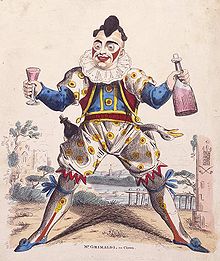Christmas at Covent Garden: 300 Years of Christmas Shows- a lecture by Sarah Lenton
Sarah clearly had an extensive knowledge of her subject and she delivered the lecture with great humour.
She began by showing us the construction of the huge Christmas tree at Covent Garden and showing how the audiences are deceived as there is no middle or back to the construction. Sarah went on to tell us that the corridors at the Opera House are always full of ‘stuff’ but much more so at Christmas. There is a real atmosphere of family on stage and the cast feel very bonded to the show they put on. They all work extremely hard especially with the costume changes.
The first theatre on the site was very tiny and very well lit with candles and oil lamps, which were always on.  In those days if the audience was displeased they would riot and go onto the stage and rip out any scenery, so as a result spikes were placed in front of the stage as these would slow them down !
In those days if the audience was displeased they would riot and go onto the stage and rip out any scenery, so as a result spikes were placed in front of the stage as these would slow them down !
John Rich – who was the director and theatre manager from 1732-1761 – geared his theatre to success and didn’t want to play to empty benches so he decided to do Christmas Shows and Harlequinades.
He defined an English harlequin – for example he stylised the patches of the Italian harlequin into the triangles that we see today. . The English harlequin had a stick with which he would bang scenery to indicate that it needed moving – and this was the beginning of the term ‘slapstick.’ The Christmas period was extended from Advent to February and this was when he made the money.John Rich spent £2000 a year on the Christmas shows but then they financed the rest of the year.
Handel was a good friend of John Rich and so he allowed him to put on shows in Lent.
During this time the backdrops were rolled up by stagehands and they used sailors as they were particularly skilled at rolling up canvas.
The theatre was burned down in 1808 and they built a second theatre
but this one sadly did not last long. . As it was much bigger than the first theatre the gestures had to get bigger and action more violent .The new theatre manager – John Kemble was the complete opposite of John Rich and hated the Christmas shows but was obliged to put them on because of the money they made. . Harlequin had been in existence for 60 years so there was a need for another character and so they created the clown. who was acted by Grimaldi.
However he thinking was that there was no place for a clown in Opera so they created the Dame.
By the Victorian era the middle classes were the audiences so they behaved in a much gentler way.
In the 1830s the Christmas shows had to have a fairy as Caraboss in Sleeping Beauty.
In the 1850s a third theatre was built
and during this time they made the performances gentler by creating a heart and emotion for the heroine.
Sarah ended this fascinating lecture by telling us that all their Christmas Shows have a happy ending. And we did.





